| |
'The violence and the brutality in the story are only a frame, not the picture. What’s important is the picture inside, not the frame.' |
| |
Václav Marhoul on The Painted Bird |
| |
'We ought to read only the kind of books that wound or stab us. If the book we’re reading doesn’t wake us up with a blow to the head, what are we reading for? We need books that affect us like a disaster, that grieve us deeply, like the death of someone we loved more than ourselves, like being banished into forests far from everyone, like a suicide. A book must be the axe for the frozen sea within us.' |
| |
Franz Kafka, 1904 |
The coronavirus pandemic has curtailed or delayed the theatrical distribution of many fine films over the last, wretched year, but no film was more cruelly ill-served by the closure of cinemas than The Painted Bird. Elegantly shot in limpid black-and-white 35mm Cinemascope, Václav Marhoul’s salutary epic was expressly designed to shimmer on the silver screen and to transfix audiences, leaving them both aghast at the depths to which humanity can plummet and appreciative of the heights to which cinema can soar. As one of the film’s lead actors, Stellan Skarsgård, told the BBC, ‘It needs the theatre in a way or, at least, a very big screen, because it's incredibly beautifully shot. The contrast between the beautiful images and the harsh, brutal story really rocks you in your seat in a strange way. Not all films are dependent on cinematic language but The Painted Bird definitely is’.
Eleven years in the making, Mahoul’s adaptation of Jerzy Kosiński’s acclaimed novel about a Jewish boy’s wartime journey to the heart of darkness was a labour of love – for Marhoul himself, his accomplished crew, and the supremely talented international cast he assembled. Actors with the drawing power of Skarsgård. Udo Kier, Harvey Keitel, Barry Pepper, and Julian Sands won’t work with any old director on just any script that comes along. Kosiński’s book and Marhoul’s script demanded something special, and all those who answered the call combined to deliver it. The technical brilliance characteristic of Czech cinema is evident in every frame of The Painted Bird, which deserved far greater reward than a fractured release, delimited audience, and often hysterical critical reception. Eureka’s Blu-ray release therefore feels like an essential act of reclamation and restitution.
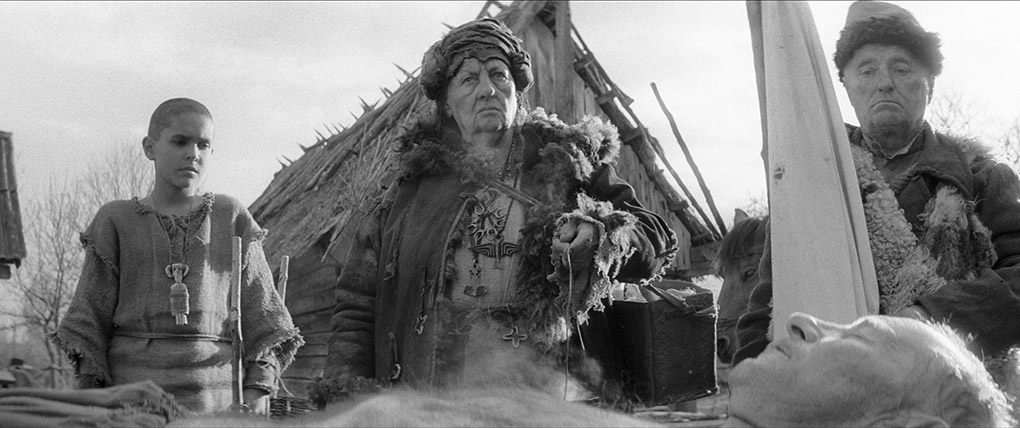
Three-hours-long, perfectly paced, exquisitely shot and impeccably acted, The Painted Bird is a haunting, harrowing, urgent reminder of humankind’s ongoing flirtation with barbarism. It delivers a timeless warning from the past to today, reminding us that the contending human capacities for cruelty and decency – each exponentially intensified by war – are timeless and universal. Neither a Holocaust film nor a war film, it is both those things and much more besides. While Kosiński’s tales of bestiality, brutality, incest, murder, mutilation and rape were set explicitly in the Second World War, Marhoul flavours his adaptation with echoes of pagan epochs and ancient fable. One of the great achievements not only of Czech cinema but of contemporary cinema, tout court, it is heart-rending and gut-wrenching, unforgettable and unmissable. Films of such coruscating force come along all too rarely; when they appear, they make most others seem superficial and implicitly challenge the assumptions of mainstream cinema. In so doing, they store up trouble for themselves, and trouble duly arrived for Marhoul and his elegant, pitch dark film.
The Painted Bird looks human depravity and moral decrepitude straight in the face, asking audiences and critics alike to consider profoundly troubling questions about the human condition as sentient adults. It is regrettable, then, that some critics elected to avert their gaze and opted for the apotheosis of the ostrich. Controversy has dogged the film ever since its world premiere at Venice, where, reports suggested, it provoked a mass exodus. The Sun claimed critics were left ‘sickened and disgusted’ by the film while the Daily Mail falsely claimed it precipitated a stampede for the exit. As Marhoul was quick to point out, while a few critics did leave the Venice screening, it also received a ten-minute standing ovation. This reviewer can confirm nobody left either the first press or public screenings of the film at the London Film Festival. On the contrary, those present responded to Marhoul’s bleak, essential film with rapt attention and enthusiastic applause – despite, or perhaps partly because of the prurient coverage of it in the gutter press. In the interim, the film has played to packed houses in the Czech Republic and it ruffled few feathers in the U.K. during a limited theatrical release cut short by the pandemic.
The film will continue to divide opinion and audiences. Prudes and Panglossian partial livers may persistently baulk at the film’s brutal honesty: others, taking life in the round, will watch it with eyes wide open. The fainthearted will always look away: other will take a leaf out of the Kafka’s book and rally behind films, like Marhoul’s, that ‘affect us as a disaster’ and ‘take an axe to the frozen sea within us’. Such stark binaries, however, significantly simplify the issues at stake. There are also those in the clear-sighted camp who revel in violence, as it has been argued Jerzy Kosiński did, and there are decent, gentle people who abhor violence to such an admirable degree that they can’t face it on film. In Reads Like a Novel, novelist Daniel Pennac argues that ‘the freedom to write cannot accommodate the duty to read’ and lists ten ‘inviolable rights of readers’ – including the rights not to read (which, as Pennac points out, millions exercise every day) and not to finish a book, to skim and to browse. People have the right to walk out of films too, but we reserve the right to upbraid those who turned their backs on The Painted Bird, thereby insulting dozens of film professionals who poured their labour and skills into its creation.
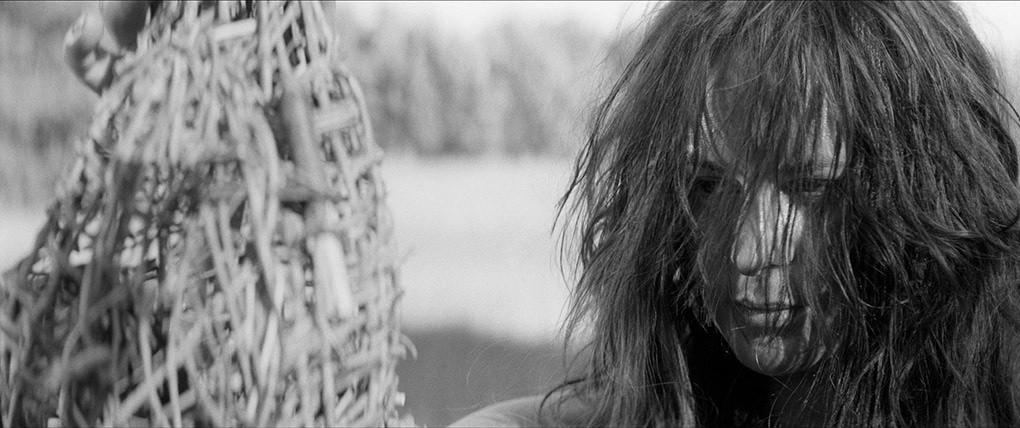
Sadly, considerations of cinema-going etiquette are currently academic. Now, other questions arise and, thanks to home viewing platforms and the likes of Eureka we also have the right to zap, to press pause or stop, fast forward and freeze frame. Small screens may shrink films, but home viewing facilitates close scrutiny of them. Armed with their remote controls, viewers can more clearly see that Marhoul’s representations of violence are far from exploitative and gratuitous, as has been claimed by many of the film’s detractors. The Painted Bird takes its place within a noble tradition of resistance to commercial compromise and revivifies ancient arguments about the very purpose and responsibilities of art. Stellan Skarsgård says, ‘It's a film of a kind that's very hard to finance nowadays. It's in the style of the classic, very cinematic films from Eastern Europe in the 60s and 70s, but it doesn't sell much popcorn and popcorn is very important nowadays’. Speaking of the film’s reception, Vacláv Marhoul, who detests the consumption of popcorn in cinemas himself, said he was delighted to observe riveted audiences watch his film without eating: ‘They simply couldn’t sit and watch my movie while eating popcorn. This is one of my biggest achievement with this movie’. We may assume he spoke with his tongue in his cheek. His film operates as a necessary rebuke to an infantilised culture and his greatest achievement may be that it appeared in the world at all.
The Painted Bird follows a forlorn Jewish boy (played with mute, mature grace by Petr Kotlár) as he staggers across Eastern Europe, maltreated at every turn, in search of his parents and an elusive ideal of home. Initially unnamed, later revealed to be Joska, he begins his struggle for survival in a region where nothing much has changed or improved for centuries – an unsullied place populated by a wretched, superstitious and primitive peasantry. Refusing to acquit humanity by indicting particular periods, places or peoples, Marhoul eschews existent language and earths the film in a primordial everywhere and nowhere. The ancient first meets the modern in the film when a Luftwaffe bi-plane flies overhead, dragging us, startled, from the middle ages into the mid-20th century. In this new dark age, the plane appears like a surreal detail from one of Abbas Kiarostami’s reproductions of Hieronymus Bosch in 24 Frames or, more pertinently, like an unscripted intrusion onto a set of František Vlácil’s monumental historical epic Marketa Lazarová.
The opening line from Vlácil’s film – ‘the oldest things lie in the present’ – might well have served as a catchline for Marhoul’s. The first half of The Painted Bird, with its meticulous recreations of long-vanished villages and landscapes and its iterations of antediluvian cultures, owes a clear debt to Vlácil’s Czechoslovak masterpiece of 1967. The second half, meanwhile, recalls Elem Klimov’s visceral classic of late-Soviet cinema, Come and See. A former General Director of the Barrandov Studio, from which Marketa Lazarová issued forth, Marhoul couldn’t have helped but be influenced by Vlácil’s work. Having witnessed unspeakable horrors while serving in the Czech army and working for UNICEF, he can only have been impressed by the unflinching honesty of Klimov’s depiction of war. But, although Klimov and Vlácil paved a path for him, Marhoul single-mindedly sculpted a hellish, ultimately hopeful masterwork all his own that stands tall even in such illustrious company.
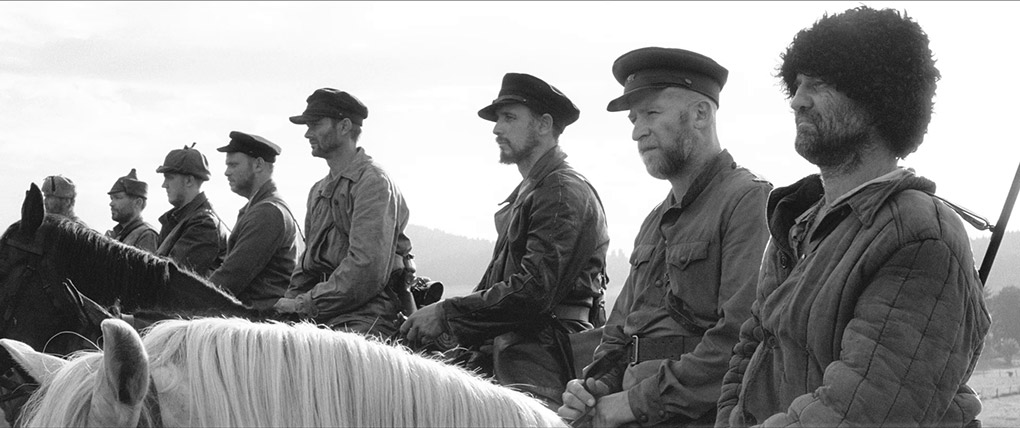
From the moment he finished Jerzy Kosiński’s novel in 2006, Marhoul was determined to adapt it. In the years between the film’s conception and completion, he immersed himself in Kosiński’s work in order to replicate the novelist’s excoriating vision of humankind gone mad. His unwavering commitment to the project testifies to a sense of deeper purpose, and the elegance of the film’s execution alone would, anyway, have been sufficient to repudiate crass accusations of exploitative amorality. Marhoul, like Kosińsk, felt compelled to expose the fragility of that trembling veneer of civilisation which separates us from barbarism. His plea for vigilance, aimed squarely at audiences desensitized to violence but also operating as a reproach to fainthearted spectators and sensationalist critics, contains implicit hope, and The Painted Bird ends on a cautiously optimistic note. The splendent grandeur of Vladimír Smutný’s black & white cinematography, with its echoes of Tarkovsky and Tarr, does much to mitigate the atrocities we behold. The beauty of Smutný’s deep focus compositions are a perfect match for the elemental splendour of the landscapes they illuminate and set the ugliness of human cruelty in stark relief.
As sad as history and hard as nails, The Painted Bird is divided into nine chapters named after the adults – by turns compassionate and callous, protective and predatory – whom the vulnerable boy encounters. The first of these custodians is an elderly relative, Marta (Nina Sunevic), to whom he has been entrusted by his persecuted parents. While in her ‘safe keeping’ in the country, a group of local lads knock the boy’s teeth out, wrench his beloved ferret from his grasp, and promptly burn it alive. As the poor thing squeals and circles in its death throes, the stage is set for worse to come. Throughout the film, the brutalities suffered by the boy are mirrored in those inflicted on animals as innocent as he initially is.
Marhoul follows Kosiński’s novel largely to the letter but subtly amends it to allow for human decency. Those few who walked out of the film might be surprised to learn that Marhoul’s vision is substantially gentler and more forgiving than Kosiński’s. His depictions of human depravity are no less visceral than Kosiński’s but they are offset by acts of kindness that feel precisely planned. Within the film’s rolling series of vignettes, we discern a faintly patterned schema that allows for light and shade in human affairs as well as cinematography. Such is the intricate sweep of the film’s hypnotically mesmerizing narrative that any summary of this sprawling epic’s plot must be partial, perhaps tiresome to the reader. It is to be hoped, though, that the attempt at precis that follows might suggest a sense of order in the juxtapositions of visciousness and virtue that inform and enhance the whole.
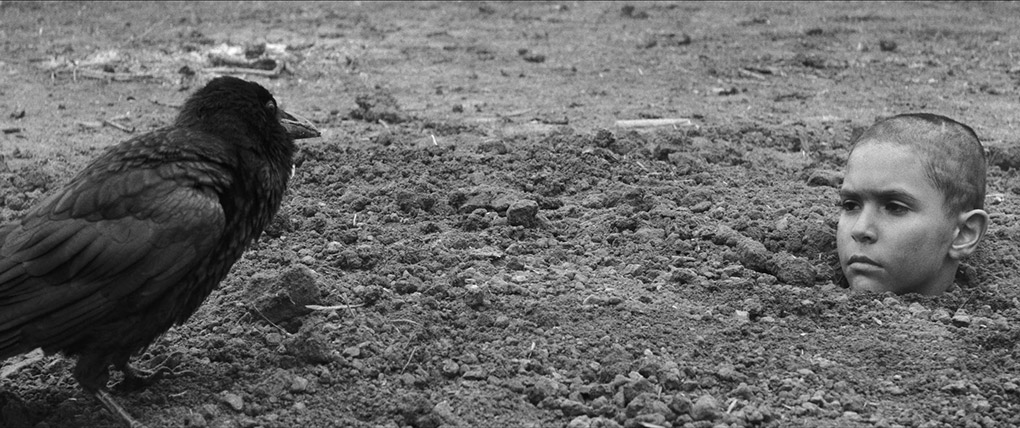
After Marta dies suddenly one night, the boy reels back in horror and accidentally burns her farmhouse down before embarking on his journey through the nightmare of war. Seized soon after by superstitious peasants gripped by blood lust, he is rescued by Olga (Ala Skalova), a shamanic mystic who intructs him in her ancient arts. She saves his life again, after he develops a fever, by burying him to the neck to draw the spirits from his soul; and yet again, by warding off the ravens who subsequently circle to peck at his exposed cranium. Separated from his grizzled saviour after tumbling into a river, the boy washes ashore at a mill. The miller (the steely-eyed Udo Kier) grudgingly tolerates him but regularly beats his wife and, finally, jealously gouges out the eyes of his covetous assistant. Forced into flight once more, the boy finds shelter with Lekh (Lech Dyblik), a kindly bird-catcher. Lekh provides the leitmotif for this cautionary tale when he paints a starling white, releases it, and watches on as it is pecked to death by its own flock. Difference spells danger for the abandoned bird-boy, bereft of love and baffled by his kind.
The repeated symbolism implicit in cruelty to creatures great and small is compacted with that of sexual dissipation to flesh out Marhoul and Kosiński’s searing indictment of moral collapse and turpitude. Unfortunately, Marhoul accepts the Madonna-whore dichotomy uncritically, but whereas Kosiński’s lascivious asides were famously reflected his own licentious lifestyle, Marhoul’s treatment of debased sexual relations seem infused with tear-drenched regret for innocence lost. Can we not rise above the level of rutting beasts, he seems to ask, and try a little tenderness? When Lekh cavorts with his half-crazed lover, Ludmila (Jitka Čvančarov), their libidinous union straddles love and lust; a fine balance that is evoked again in Lekh’s devasted reaction to her violent murder by enraged local women. Already the boy has learnt that animal sexual desire can unhinge adults; inevitably, the beatings and the rape he endures inures him to the false teachings of adult cruelty. When he finds further refuge with a farmer’s daughter whose unsatisfied desire turns against him, we are as appalled by her cold-hearted rejection of the boy’s palpable yearning for affection as her recourse to bestiality. In the timeworn tradition of damaged youth, he takes his pain and anger out on one weaker than himself, in this instance a favoured goat.
Having slammed the door to this latest refuge firmly shut, Marhoul spares us nothing. The Boy struggles on and stumbles upon a wounded horse. Taking pity on the hobbled quadruped, he leads it on to a village – for help but, unwittingly, to its death. At this point the film swivels on its axis and war bursts into its flame-dark frames in the shape of brutish Cossacks. Their leader force-feeds the boy vodka before turning him over to Nazis for sport. A decent Wehrmacht soldier, Hans (Stellan Skarsgård) takes pity on him and volunteers for execution duties in order to save his life.
No pity is evident in the subsequent scenes of barbarism, in which the Boy sees Jewish prisoners escape from transportation cattle trucks only to be mown down in cold blood. In the despicable dog-eat-dog pillage that ensues, first the local peasants and then the debased boy himself stoop to loot the corpses. Captured by the SS, the Boy successfully grovels for his life and is taken in by a well-intentioned priest (Harvey Keitel). Here Marhoul departs from the source novel and draws on Kosiński’s life. Although the novelist allowed the legend to develop that his blistering book was autobiographical, he was sheltered during the war by Catholics and became an altar boy at their behest. The film’s young protagonist, too, dons the cassock to survive but his abnegation only adds to his stock of suffering.
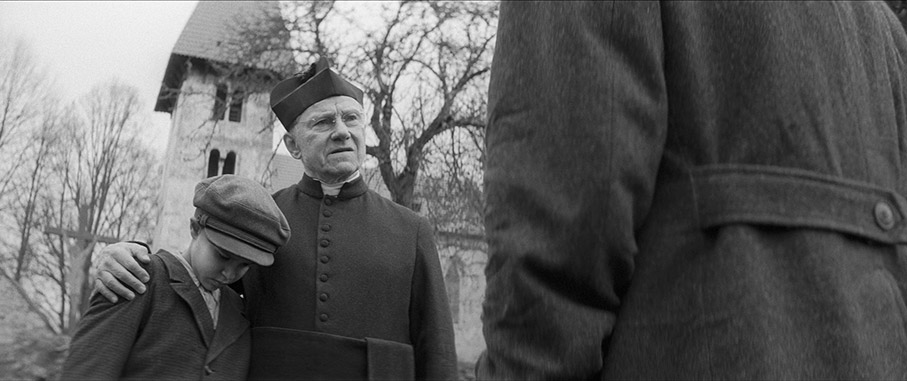
The criminally naïve priest entrusts the boy to a repellent paedophile, Garbo (Julian Sands), who rapes and tortures him repeatedly until The Boy lures him to a death too blood-curdingly gruesome to either describe or forget. After returning, in his desperation, to the church, he drops the Bible during a service and is tossed into an excrement-laden latrine as punishment. The next village in his odyssey is attacked by Cossacks in league with the Nazis. They are driven off by the advancing Red Army – in whose ranks The Boy finally finds the role models and father figures he has craved, men of committed compassion with his best interests at heart. Terrified, and schooled by grim experience to be wary, the soul-dead boy flinches fearfully when confronted by unexpected decency. Here, Marhoul tips his cap not only to the Red Army but also to Klimov’s Come and See – by introducing us to that most controversial of figures ‘the good Communist’ in the form of Gavrila (Aleksei Kravchenko, who played the boy, Florya, in Klimov’s masterpiece). Deluded Stalinist though he is, hardened by and for war though he is, Gavrila, shows the boy genuine tenderness. He implicitly appeals to the boy’s damaged sense of trust and invites him into his tent to meet his comrade-in-arms, the sniper Mitka (Barry Pepper). The boy fears the worst and so do we.
For once in the film, our fears are unjustified. The world-weary combatants take the boy under their wing in moving, unspoken solidarity. After four men from their unit are slaughtered by the local peasantry, Mitka teaches the boy another (false) lesson, ‘an eye for an eye’, as he skilfully picks off four hostile locals in retribution. As the film nears its harrowing but hopeful climax, Gavrila, Mitka and the Red Army pull out to begin their push to Berlin and the belly of the beast and the boy is sent to an orphanage. His innocence reawakened, he is violently assaulted, one last time, by a swivel-eyed anti-Semite as he stands, in a reverie, admiring a toy horse freighted with symbolic meaning, The film’s enigmatic finale must remain a mystery but we are left with a strong sense that the boy’s capacity for love remains intact and his grim odyssey will not have been in vain. In the words of R.S. Thomas, he is a traveller arrived ‘after long journeying, where he began, catching this one truth by surprise, there is everything to look forward to’. As the credits roll, we are also left looking forward to more from Václav Marhoul and Vladimír Smutný, indeed, from all those whose commitment, expertise and intelligence helped The Painted Bird soar to the highest conceivable heights.
Framed in its theatrical aspect ratio of 2.39:1, the 1080p transfer here is absolutely pristine, with a lovely presentation of Vladimír Smutný's gorgeous monochrome cinematography that displays really crisp picture detail, a handsome tonal range and sublimely balanced contrast. As you would expect of a modern transfer, there's not a mark on the image, and a very fine film grain is visible (the film was shot on 35mm).
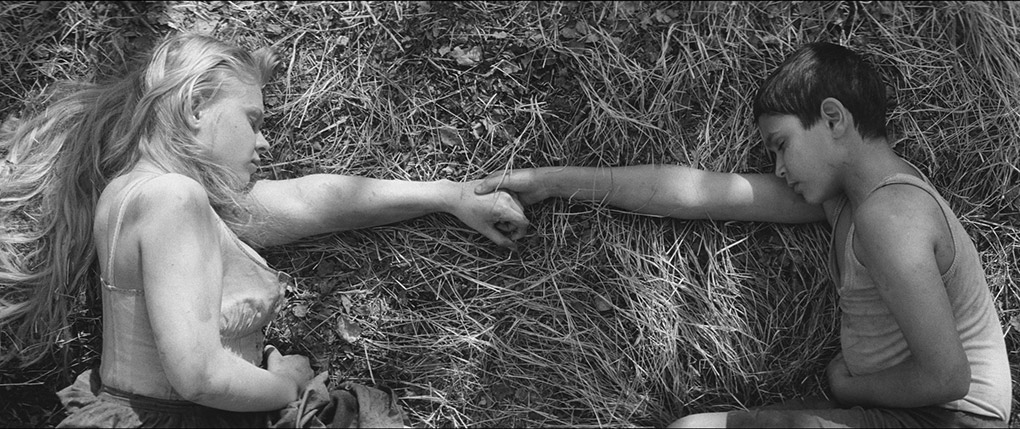
The DTS-HD Master Audio 5.1 Czech surround soundtrack is similarly impressive, being crystal clear and boasting a strong dynamic range, with clean rendition of trebles and a strong bass response when appropriate. Separation is distinct and sometimes striking, with rainfall, crowd scenes and the sounds of a hosebound attack spread all around the room, placing the viewer right in the centre of the action.
Optional English subtitles are activated by default.
Eureka’s Blu-ray release of The Painted Bird is accompanied by an aptly elegant booklet featuring a gallery of stills from the film and ‘Fear and Trembling’, a contextualising essay by esteemed academic, critic and curator Jason Wood. He usefully elaborates on the heightened authenticity achieved by two of Marhoul’s most significant decisions: to shoot on black-and-white film rather than digitally and in colour, and to deploy a Slavic Esperanto rather than any living language. But, to tell it as I see it, this erudite, engaging but slight essay fails to do the film justice. Marhoul’s extraordinary epic called for more comprehensive coverage than Wood (or myself!) deliver and one can’t help wondering what a historian of Czech cinema such as, say, Peter Hames might have made of it. Wood makes no mention of the film’s antecedents in Czech cinema (a national film culture that has always punched above its weight), disregards Marhoul’s vital work as scriptwriter and producer on the film (almost as important as his directorial virtuosity), and avoids all discussion the film’s budget (which merits an essay in itself). Wood elects, instead, to focus on Jerzy Kosiński’s chequered career and source novel – which he describes as ‘one of the great masterpieces of 20th century literature’. He devotes considerable further space to discussion of Hal Ashby’s superb film Being There (another adaptation of another Kosiński novel), but his comparison of Ashby and Marhoul’s films is stretched beyond breaking point. Jason Wood is a perceptive critic capable of better work, so one can only assume he had seen the ‘making of’ documentary that graces this release before writing for it and sensibly opted to cover aspects of the film untouched upon therein.
11 Colours of the Bird: The Making of The Painted Bird
If Wood’s essay disappoints, this two-hour-long documentary delights. It offers an engrossing commentary on the 11 years of the film’s production process and 100-day shooting schedule and provides rare insight into the art of filmmaking generally. If the intense, immersive experience of The Painted Bird leaves us feeling we have accompanied The Boy on his journey, this documentary makes us feel we’ve been on a fruitful journey with its cast and crew. It opens with an image of Petr Koltár, the photogenic child actor who plays The Boy to such dazzling effect in Marhoul’s film. Koltár was just nine when shooting began and we watch him grow, physically and artistically, during filming. We see that growth too in this chronological record of the film’s creation, even sharing his 10th and 11th birthdays with him as we watch.
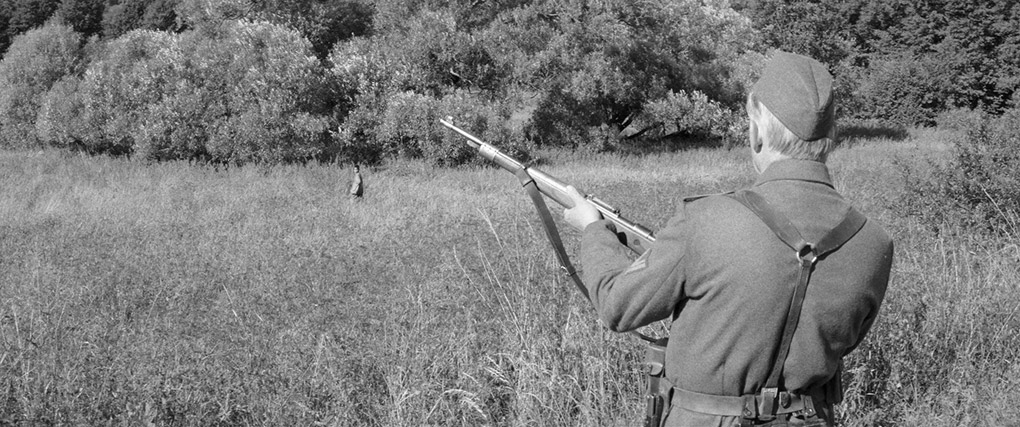
Prologue. April 2009. After a couple of years of correspondence and pleading, Marhoul flies to Chicago for a panel interview at the Spertus Institute for Jewish Learning and Leadership. After an hour-long interrogation, he is finally granted the rights to Kosińki’s novel. Marhoul immediately begins work on the script, drafting 17 different versions, over three years, with a team of eight script editors (five Czechs, three Americans).
Marhoul tells a shaggy dog story about how he stumbled upon his lead actor. Each day, after working on the script in the city of Český Krumlov, he’d retire for refreshments to his local, The Cikánka (‘The Gipsy’) – a pub run by his friend Milan Kotlár and his wife Vêrka Kotlárova. One evening back in 2013, he saw Milan’s grandson, Míša, playing fiddle in the pub. He looked, Marhoul says, like a Romany Franz Kafka and exactly matched his mental image of The Boy. To confirm he’d found his lead, he took Míša on a canoeing expedition, only to discover the introverted kid was too shy for acting. Marhoul’s search for his lead would continue for another two years. Then, while introducing a Czech-American army sports event in September 2015, Marhoul was hailed by Míša’s brother Petr, who fitted the bill perfectly. The lead actor having been cast, production on The Painted Bird officially began on the 5th of October 2016, which, by a happy coincidence, is Václav Havel’s birthday. It must have felt like a good omen.
First Colour. Shooting finally begins, in March 2017, near Bezdêz Castle in Northern Bohemia. The opening sequence sees the crew working on a tracking shot of Kotlár running through woodland, pursued by a boom operator and holding two ferrets: one real and one stuffed. We are reassured that it is the model that is burnt on set, not the real ferret. Throughout the film great care is taken to ensure the well-being of all the animals used. The birds, cows, ferrets, hens and horses were all unharmed.
Second Colour. March/April 2017. We’re party to Marhoul’s two-year-long search for locations and see the crew relocate to an area a day’s drive from Lvov airport, on the border between the Ukraine and Belarus. A farmstead is constructed that will ultimately be filmed burnt down. Chef Michal Hromas feeds the cast and crew. Child-psychologist Filip Šinkner and Assistant Director Martàs Stádník make sure Petr Kotlár remains calm and content. Actress Nina Shunevych, who plays Marta, says of the film, ‘I’m sure cinema-goers won’t remain indifferent. I hope their hearts quiver’. After a month location in the Ukraine, the crew enjoy a farewell party. Beer flows and folk songs are played that will later make their way into The Painted Bird.
Third Colour. April 2017. The crew return to the Czech Republic. At a location in the Brdy Hills, Petr Kotlár is placed in a pit for a scene in which The Boy is attacked by ravens. Snow falls while the scene is being shot and we see Kotlár covered with towels to protect him from the elements. We meet his stunt double but appreciate the arduous physical challenges face by the child actor during the shooting of such scenes.
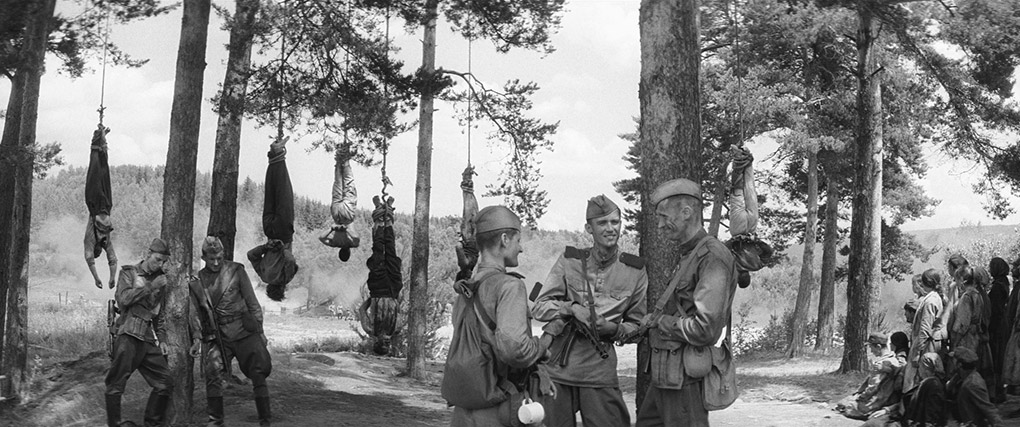
Fourth Colour. May 2017. Shooting continues in Slovakia at a location near the River Little Danube. A mill that has stood since 1895 is cosmetically enhanced for the gruesome miller’s cottage scenes involving Udo Kier, Míša Doležalová, and Zdenčk Pecha. With Udo Kier’s departure, an on-set tradition is established, to be maintained throughout the production: henceforth Vacláv Marhoul will seize departing actors in a bearhug and lift them off the ground by way of final farewell.
Fifth Colour. June 2017. We meet Polish actor Lech Dyblik, who plays the bird catcher in the film, and Czech actress Jitka Čvančarová, who plays his lover Ludmilla. Čvančarová says, ‘There hasn’t been a film like this before and I don’t think there will again. This has been exceptional work with wonderful people’. Marhoul discusses his use of an Interslavic Esperanto in his film, which also features Czech, German and Russian.
Sixth Colour. August 2017. 50 days into filming, the team return to the Czech Republic, where they are joined for a couple of days by Stellan Skarsgård. Back in 1995 (a year before Skarsgård made his name in Lars von Trier’s Breaking the Waves), Vacláv Marhoul and he had shared a drunken night in Prague and the two have been fast friends ever since. We meet actor Milan Šimácek, one of many among Marhoul’s cast to have long revered Kosińki’s novel. We are saddened to learn that he never saw the finished film, having died a year before its Venice premiere. The scene in which Nazis slaughter escaping Jewish prisoners contains one bright note: it features the rail car that first appeared in another classic of Czech cinema, Closely Observed Trains.
Seventh Colour. November 2017. Marhoul finally gets a rare night in his own bed as the production moves to his hometown of Český Krumlov. We meet actor Tomáš Kraus, who plays a persecuted Jew here and is himself Secretary of the Jewish communities of Bohemia and Moravia. Kraus’s character is killed in cold blood by an SS officer chillingly played German actor Tim Kalkhof, who says of The Painted Bird, ‘It is not a war film . . . it is a shout-out to humanity’. Harvey Keitel arrives on set, bearing the gift of a GoPro camera for Petr Kotlár. Keitel speaks of his admiration for European directors, his regrets about not being offered more roles in Europe, and his delight at playing a part in a language that doesn’t exist. Almost as Harvey Keitel leaves, Julian Sands arrives. Shooting continues in the Boletice military training area in the Šumava Mountains. For scenes shot in the 12th century St Nicholas’ Church graffiti left behind by occupying Soviet troops has to be painted over. After a crisis meeting of cast and crew, there is now a four-mouth-long break in the production as Marhoul and his producer leave to raise an additional 21million koruna so it may continue.
Eighth Colour. January 2018. Production continues after Marhoul secures a loan from the one bank he approached that would consider advancing him additional credit. During the enforced break Petr Kotlár has been ordered to let his hair grow wild. The now shaggy boy complains of being mocked by his schoolmates but soon has other worries as shooting resumes, in sub-zero temperatures, on frozen Lake Lipno. Things soon take an even more chilling turn. After the Polish parliament passes legislation criminalizing discussion of Polish complicity in the Holocaust, a blizzard of hostile criticism rains down on Marhoul and The Painted Bird. With support for the right-wing Law and Justice Party surging, a wave of xenophobic, nationalist hysteria engulfs the film. Just as Olga Tokarczuk and Agneiszka Holland were at the time, Marhoul is vicously attacked in the Polish press. He loses his Polish producer and, although he appears sanguine about political developments, he also says, ‘It’s only the beginning’.
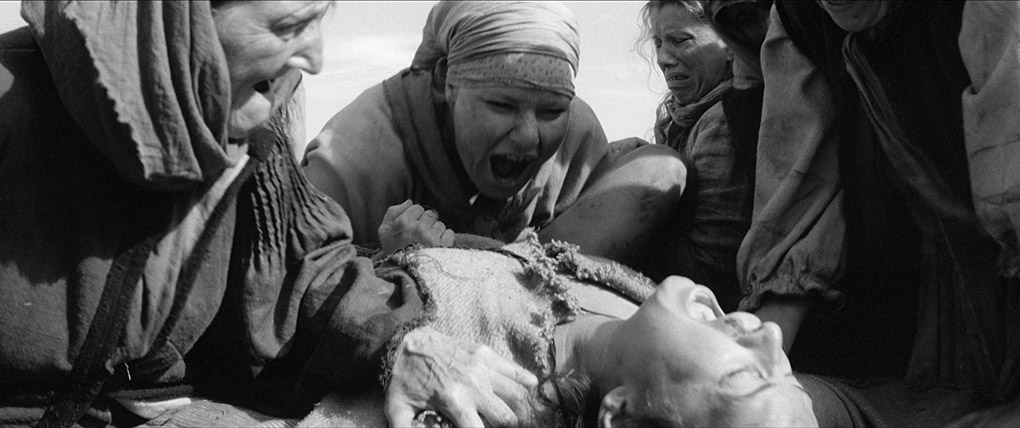
Ninth Colour. April 2018. Filming continues on Lake Lipno, at a purpose-built lakeside settlement that can only be filmed from within the still icy water, and at Řepora, the medieval village museum where many of the film’s interiors where shot. Júlia Valentová, who bears more than a passing resemblance to Magda Vášáryová of Marketa Lazarová fame, discusses her role as a sexually frustrated peasant girl. Of the graphic part she plays, she says, tellingly, ‘many girls refused the role’.
Tenth Colour. June 2018. Cast and crew return to the Boletice military training area in the Šumava Mountains to shoot the scenes in which marauding Cossacks are driven off by the advancing Red Army. Barry Pepper and Aleksej Kravchenko join the crew. Pepper plays a taciturn sniper and, although left-handed, prepared for his role by learning to fire his rifle as if he were right-handed. Marhoul confesses his nerves about the immaculately choreographed set-piece battle scenes in which Cossacks sack a village and are subsequently driven off. He marvels at the confidence of his crew: ‘I envy them how sure they are that it’ll all work out’. Despite losing a day’s filming due to heavy rain. at a point they were due to film Poland in three days’ time, things do work out: the rain passes over and the film is blessed with clear blue skies.
Eleventh Colour. June/July 2018. The final eleven days of filming take place in an ancient prison in Brno Cejl, where prisoners were incarcerated for over two centuries and which, in more recent times, served as an orphanage. We’re again offered insight into how Petr Kotlár must have felt during the filming and, as we see him learn to fire a pistol and lie still beneath a moving train, of the trials he underwent during filming. Discussing the scene in which an unhinged anti-Semite attacks The Boy in a market, he says, ‘I didn’t have to pretend anything. He really scared me stiff’. After 100 days of being without his friends, family and beloved dog Dodík, his boy’s own adventure as. The Boy is over. With nobody remaining to hoist in the air, Vacláv Marhoul proposes a toast to the health of his crew, his cast, and The Painted Bird. He has tears in his eyes as he concludes simply, ‘Eleven years of my life’ – and so do we.
Profoundly troubling but irrefutably powerful, The Painted Bird is not only one of the great achievements of Czech cinema but of contemporary cinema – full stop. The splendour of Vladimír Smutný’s cinematography and the humanity of Václav Marhoul's vision does much to offset the unrelenting brutality of Jerzy Kosińki’s source novel. This expertly executed salutary tale operates as a rebuke to an infantilised culture, a corrective to commonplace comic-book representations of violence, and an encomium to the art of cinema. Eureka’s Blu-ray release of the film grants wider circulation to an imperishable act of witness that demands to be seen. In the absence of cinemas, it is reassuring to know that this dark, vital film will still find its mark; in the absence of anything comparable, it is heartening to hope its reputation will continue to grow. Highly recommended, if for adults only.
|